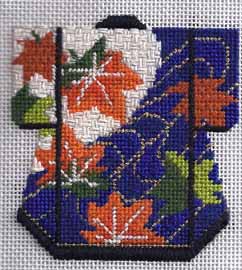
Updated March 3, 2020.
The multi-colored leaves in this mini kimono from Lee Needle Arts (currently discontinued) are just perfect to show needle-blending and the wonderful effect it has on needlepoint. On the unstitched canvas pictured here, there are four different colorings of leaves. The orange leaves are solid. The green leaves have an obvious line between the two shades. The orange leaf has a less obvious distinction between the shades, and the remaining leaves blend the two colors. In this one little piece you will see two types of shading in contrast with non-shaded leaves.


The solid orange and two-tone green leaves are stitched with no blending. I picked a textured stitch for the orange leaf and it looks great. But notice the green leaves. by stitching in only two colors, a hard line if created. There is no transition. This can look OK if the two colors are close in value, but it always makes the item look less realistic. Adding something like Whipped Backstitch as a vein, can visually divide the space and make the divided eaf look better.

The two-shade orange leaf uses a blended needle of two strands of each shade of orange to create a transition zone. Although there isn’t much room for shading, see how much more realistic this leaf appears?

The three-shade leaves are the most challenging. Not only is there shading between the two oranges, there is shading between the dark orange and green. Often on canvases, such as this one, that need this kind of shading, the shading is painted on the canvas.
The green-orange shading uses a blended needle with two strands of each color. The shaded area is always irregular on both sides. There should be no more than three stitches in a row. This keep the eye from seeing a pattern. Bumps, with a stitch or two sticking up, or holes, with a stitch or two missing can both be used to make the edge irregular. The line should not be the same on both sides. This is important because it keeps the eye from seeing this as a definite area, so your brain uses it visually to blend the two colors.
This canvas is small and so are the areas to blend. But the size of the blending should always match the size of the adjacent solid areas. Larger areas will need to have larger blended areas
Shading is a great tool to have in your needlepoint bag of tricks. It allows you to make subtle and realistic transitions. With it you can create colors not found in threads. You can also use it to create subtle effects on canvas. As you can see, it’s simple to do and makes your needlepoint look so good.
About Janet M Perry
Janet Perry is the Internet's leading authority on needlepoint. She designs, teaches and writes, getting raves from her fans for her innovative techniques, extensive knowledge and generous teaching style. A leading writer of stitch guides, she blogs here and lives on an island in the northeast corner of the SF Bay with her family

Leave a Reply